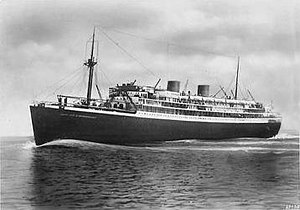Lakonia disaster

An early photo of the Johan van Oldenbarnevelt
|
|
| History | |
|---|---|
|
|
|
| Name: | Johan van Oldenbarnevelt |
| Owner: | Netherland Line |
| Operator: |
|
| Route: |
|
| Builder: | Nederlandse Scheepsbouw Maatschappij of Amsterdam |
| Launched: | 3 August 1929 |
| Completed: | 13 March 1930 |
| Decommissioned: | 3 February 1963 |
| Refit: |
|
| Fate: | Sold to the General Steam Navigation Company of Greece and renamed TSMS Lakonia |
|
|
|
| Name: | TSMS Lakonia |
| Owner: | General Steam Navigation Company of Greece |
| Port of registry: | Greece |
| Acquired: | 8 March 1963 |
| Fate: | Burned in a fire at sea 22–24 December 1963 and sank while under tow 29 December 1963 |
| General characteristics | |
| Class and type: | Ocean liner |
| Tonnage: | 19,040 tons |
| Length: | 609 ft (186 m) |
| Beam: | 74.8 ft |
| Decks: | 7 |
| Installed power: | two Sulzer diesel engines |
| Propulsion: | two propellers |
| Capacity: |
|
The TSMS Lakonia was a Greek-owned cruise ship which caught fire and sank north of Madeira on December 22, 1963, with the loss of 128 lives.
The vessel was built in the Netherlands as the MS Johan van Oldenbarnevelt and sailed regularly between Amsterdam and the East Indies. The ship served as an allied troopship during World War II. She was sold to the General Steam Navigation Company of Greece in 1962.
Renamed Lakonia, the ship completed a successful cruise from Southampton to the Canary Islands in April 1963, planned as the first of a long series. On December 19, she departed Southampton for an 11-day Christmas cruise with 646 passengers and 376 crew under Captain Mathios Zarbis.
On the fourth evening of the voyage, a steward found the ship's hair salon ablaze, with flames spreading quickly toward the passenger cabins. Alarms sounded too softly to be heard by most people on board.
Evacuation was hampered by the overcrowding of lifeboats and the loss of several boats to fire. Some passengers were able to reach the water via the gangways and rope ladders. Two ships alerted by distress signals managed to save most of the others.
A board of inquiry traced the fire to faulty electrical wiring, but strongly criticised the maintenance of equipment, thoroughness of boat drills, and the standard of supervision. Eight of the ship's officers were charged with negligence.
The MS Johan van Oldenbarnevelt was built in Amsterdam at the Nederlandse Scheepsbouw Maatschappij, dockyard 194. The ship was launched on August 3, 1929 and construction was completed on March 13, 1930. She was powered by two propellers and two Sulzer diesel engines and had a maximum speed of 19 knots (35 km/h). The ship was 609 feet (186 m) long and measured 19,040 gross tons. The Johan van Oldenbarnevelt originally could accommodate 770 passengers: 366 in first class, 280 in second, 64 in third and 60 in fourth class. She could also carry as many as 360 crewmen. The ship had seven passenger decks and could carry 9,000 tons of additional cargo.
She was originally operated by the Netherland Line, and sailed between Amsterdam and the Dutch East Indies for nine years. Along with her sister ship, the Marnix van St. Aldegonde, the Johan van Oldenbarnevelt was the largest Dutch ship at the time she was built. She was the eighty-ninth ship built for the Netherland Line.
...
Wikipedia
